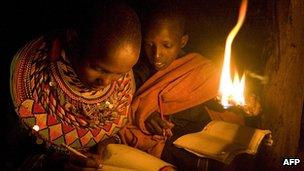Solutions sought to end use of kerosene lamps
- Published

Once a week Badriya walks six miles from her village in East Tanzania to the nearest shop, where she spends a quarter of her family's weekly earnings on kerosene so she can light her home.
She is one of nearly two billion people across the globe who have no access to electricity.
Kerosene lamps are widely used for lighting in rural areas of Asia and Africa where electrical distribution is either not available, or too costly for widespread use.
Yet using kerosene for lighting is extremely inefficient, dangerous and expensive, and it has extensive health and environmental drawbacks.
The World Bank estimates that breathing kerosene fumes is the equivalent of smoking two packets of cigarettes a day and two-thirds of adult females with lung cancer in developing nations are non-smokers.
A number of non-government organisations (NGOs) are committed to eradicating the use of kerosene lamps by introducing solar power.
One such NGO is Sunny Money, and managing director John Keane emphatically points out that it is an NGO which firmly believes in business-based solutions.
"We have always been about creating a sustainable business model. The challenge has been to help people to start up their own businesses to sell solar products, and to build a momentum in the market," he says.
Citing the mobile phone as an example in Africa - the NGO is trying to replicate that, to sell affordable products - lanterns, phone chargers, lights for a few rooms, costing anything from $8 to $100 (£5-£62).
"We try to identify entreprenuerial-minded people who would be able to explain solar products," he says.
They intend to raise awareness, raise trust, and raise the belief that solar is a viable option.
To garner new ideas on how it might be able to achieve its aims, the NGO collaborated with the Hult International Business School in the US.
The school organised a competition which challenged young people to come up with innovative ideas to create sustainable energy in some of the world's most impoverished countries - with the winning team receiving $1m (£620,000) to enable them to test and develop their ideas.
"We are hoping students can take a step back and look at opportunities differently," says Mr Keane.
"We recognise it is a huge challenge but also a massive opportunity."
Bright ideas
Micah Melnyk from a Cambridge University team which took up the Hult challenge, says: "Energy is so fundamental to development, we have a responsibility to alleviate poverty around the world."
He notes that solar is a good opportunity as it can be implemented on a small scale, whereas something like hydropower could not be installed at household level.
He believes results can be achieved by using mobile phones for a pay-as-you-go energy supply, whereby small-scale energy systems can by installed in homes and paid for on a micro-basis.
"They do not have to pay all upfront," he says. "The equipment installation package will be paid for over time and the mobile phone can activate payments on a weekly or monthly basis."
He says it is important to reflect how people already live, such as buying kerosene on a regular basis.
"Cultural imperialism will not work," he says, "We have to work with existing culture and way of thinking."
Dual purpose
Somebody else who has experience of providing solar energy to markets in Africa is Simon Bransfield-Garth of Azuri Technologies, a solar power company based in the UK.
He says that the challenge was to look at somebody only earning $3 a day, and how it was very difficult for them to spend $50 or $60 on a high-quality solar power system.
The product he came up with comprises a solar panel with a battery and two lights, and a port that enables people to charge their mobile phones.
"Instead of people having to spend $50 to buy the product in the first place, they are able to get the product for between $5 and $10, and then they buy a scratchcard every week, which costs about a $1, and they use that scratchcard to pay for the system in exactly the same way as you would if you had a pay-as-you-go mobile phone," he explains.
"In Kenya, we found customers were paying $1 a week for the scratchcards, but they were saving $2 a week on a combination of their spend on kerosene and mobile-phone charging," he says.
"People have an incentive to use this system because they are saving money from day one," he says.
With so many people trying to find solutions for low-cost sustainable energy, the future might soon be looking a little brighter for Badriya and millions of other inhabitants of Africa.
- Published2 March 2012
- Published23 December 2011
- Published2 July 2010